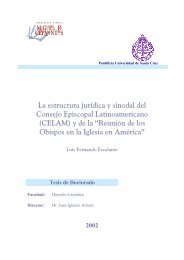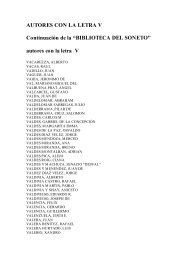Create successful ePaper yourself
Turn your PDF publications into a flip-book with our unique Google optimized e-Paper software.
Anales galdosianos [Publicaciones periódicas]. Año XII, 1977<br />
entre lo que se ve y lo que se esconde ». Thus she can say: « Tristana, a pesar de su sencillez<br />
de asunto, aún le sobra parte de él: para el asunto interno no hacía falta Horacio, ni la ausencia de<br />
Horacio, ni la pierna cortada, porque el asunto interno en Tristana no es realmente ni la seducción<br />
de don Lope, ni el enamoramiento de Horacio, ni la ruptura, ni el casamiento final... » 201<br />
Critics that came later would agree with her: Casalduero and Marina Mayoral, who condemned<br />
<strong>Galdós</strong> for arbitrarily crippling his heroine in more ways than one; Emilio Miró who declares: «<br />
<strong>Galdós</strong> ha escrito una novela muy cruel. Parece que se ha burlado sangrientamente de su criatura, que<br />
se ha complacido en abatirla, en humillarla » 202 . Along with Berkowitz, they would also agree with<br />
la Pardo Bazán's description of the theme, or asunto interno , as: « el despertar del entendimiento y la<br />
conciencia de una mujer sublevada contra la sociedad que la condena a perpetua infamia... » and here<br />
is the crux of the matter. For, what if that were not the actual theme? What if <strong>Galdós</strong> meant to convey<br />
something else? After all, Doña Emilia found the central idea to be « embrionaria y confusa ». 203<br />
I said before that it is fruitless to speculate about <strong>Galdós</strong>'s attitude toward feminism. I meant that<br />
we should not try to see in him either a defender or enemy of women's rights. I would say that what<br />
intrigued him most in the matter is the conflict that a feminist is heir to -the conflict in terms of inter-<br />
personal relationships and, only in a secondary way, the social and economic implications that might<br />
arise from her stance. Again, this does not mean that he discounted the importance of the latter but<br />
simply that in him the «artist» took precedence over the «sociologist».<br />
To be sure, <strong>Galdós</strong> was sympathetic to the plight of Spanish women. He seems to acknowledge the<br />
injustice in the circumstances that barred Tristana from being a lawyer, doctor or minister, but he is<br />
more concerned with her personal quandary (her yearnings and her doubts) and with the way men<br />
would take to her and she to them. The world of feminine emotions had always fascinated <strong>Galdós</strong> and<br />
in Tristana's rebellion he heard discordant voices that held his attention. He was no longer the liberal<br />
reformer who would protest against injustice explicitly; his message could only come through in an<br />
implicit manner; any thesis must now succumb to the drama of his fictional characters. Inherent in the<br />
201 Op. cit. , p. 1120.<br />
202 Op. cit. , p. 521.<br />
203 Clarín disagreed with Doña Emilia: « La señora Pardo Bazán ve no sé qué esbozos de gran novela,<br />
que no llega a escribirse, y cuyo asunto sería la esclavitud moral de la mujer. No creo que Tristana<br />
represente tal cosa ». ( Op. cit. , p. 252.)<br />
151

















